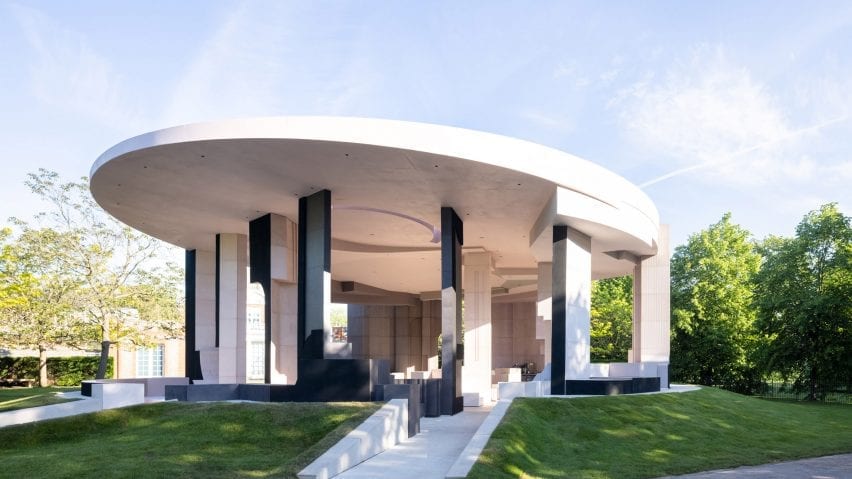South African studio Counterspace led by architect Sumayya Vally has unveiled a pink and grey structure built from elements informed by buildings in London as this year's Serpentine Pavilion.
The coronavirus-delayed structure designed by Vally was designed to reference informal meeting spaces in areas of London that have large migrant populations.
"My practice, and this pavilion, is centred around amplifying and collaborating with multiple and diverse voices from many different histories; with an interest in themes of identity, community, belonging and gathering," said Vally.
Counterspace's pavilion is the 20th temporary structure to be built in Kensington Gardens near the Serpentine Gallery as part of the annual programme.
Vally, who was recently named one of Time magazine's 100 leaders of the future, is the youngest architect to receive the prestigious commission.
Dezeen has published an exclusive video interview with Vally about the pavilion and has partnered with the Serpentine Gallery to live stream a conversation between her and Serpentine Galleries artistic director Hans Ulrich Obrist at 1:00pm London time on 9 June.
To create the pavilion, Vally spent four months in London investigating spaces of gathering that were significant to migrant communities.
These include the Fazl Mosque and East London Mosque, which were some of the first mosques built in the city, the Centerprise cooperative bookshops in Hackney, The Four Aces Club on Dalston Lane and The Mangrove Caribbean restaurant in Notting Hill.
Abstracted elements of each of these buildings and many structures that have been demolished were combined to form the pavilion's columns and inbuilt furniture.
The resulting pink and grey structure was built from a steel frame wrapped in plywood timber that was CNC-cut to give the building's intricate reliefs.
These boards were largely covered with pink and grey micro-cement sealed with water-based resin, with several black-stained cork panels positioned on the exterior of the pavilion.
Vally and the organisers aimed to create a pavilion that had a minimal carbon impact. Like all of the previous pavilions, it will be fully dismantled at the end of the summer, when it will be relocated and re-erected by its new owners, spa operator Therme Group.
Consultant AECOM produced a carbon report that takes into account the construction of the building along with its dismantling and transportation of the structure at the end of the summer that concluded the pavilion is a carbon-negative structure.
"When we started 18 months ago, our aim was to do everything to minimise the carbon impact," explained David Glover, technical advisor for the Serpentine Pavilion.
"If you had asked me at the time if we could build a zero-carbon temporary building that needs to be dismantled, removed and rebuilt I would have said it wouldn't be possible – so I always said it would have the 'lowest possible carbon'," he continued.
"But in the end, we built a carbon-negative structure."
The temporary building achieved this primarily by making use of steel that had already been used several times by contractor Stage One.
However, the temporary pavilion sits on an 85-square-metre concrete foundation slab that drew criticism when it was poured earlier this year.
According to Glover this slab, which has an average depth of 250 millimetres and was built from low-impact concrete, was necessary due to the height of the pavilion.
After the pavilion is dismantled the slab will be broken up and crushed and reused locally – something that was taken into account in the carbon report.
Along with the main pavilion in central London, four fragments of the building have been constructed across the city to extend the reach of the project.
They have been built at New Beacon Books in Finsbury Park, The Tabernacle in Notting Hill; The Albany arts centre in Deptford and Valence Library in Barking and Dagenham.
"The past year has drawn these themes sharply into focus and has allowed me the space to reflect on the incredible generosity of the communities that have been integral to this pavilion," Vally said.
"This has given rise to several initiatives that extend the duration, scale and reach of the pavilion beyond its physical lifespan. In a time of isolation, these initiatives have deepened the pavilion’s intents toward sustained collaboration, and I am excited to continue this engagement with the Serpentine's civic and education teams and our partners over the summer and beyond."
Founded in 2005, Johannesburg-based collaborative architectural studio is directed by Vally. She is the latest architect to design the Serpentine Pavilion since Zaha Hadid created the first in the series in 2005.
Since then, pavilions have been built by numerous architects including Frida Escobedo, Bjarke Ingels and Sou Fujimoto. 2019's pavilion was designed by Junya Ishigami as a "hill made out of rocks". Next year's pavilion is set to be designed by American artist Theaster Gates.
Photography is by Iwan Baan.
The Serpentine Pavilion 2021 is open to the public in London from 11 June to 17 October 2021. Dezeen is live-streaming a talk with architect Sumayya Vally about the pavilion at 1:00pm London time on 9 June 2021. See Dezeen Events Guide for an up-to-date list of architecture and design events taking place around the world.

